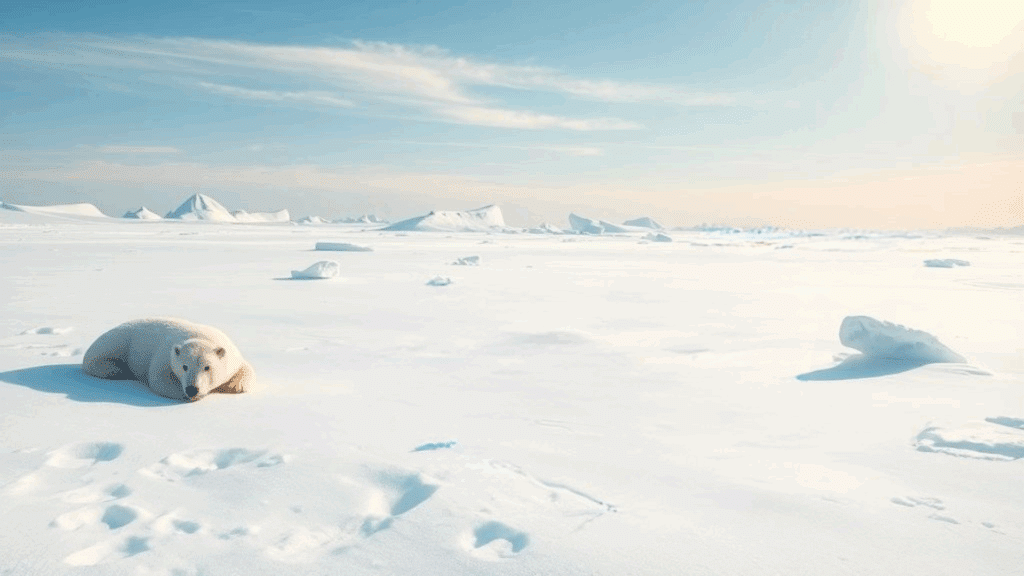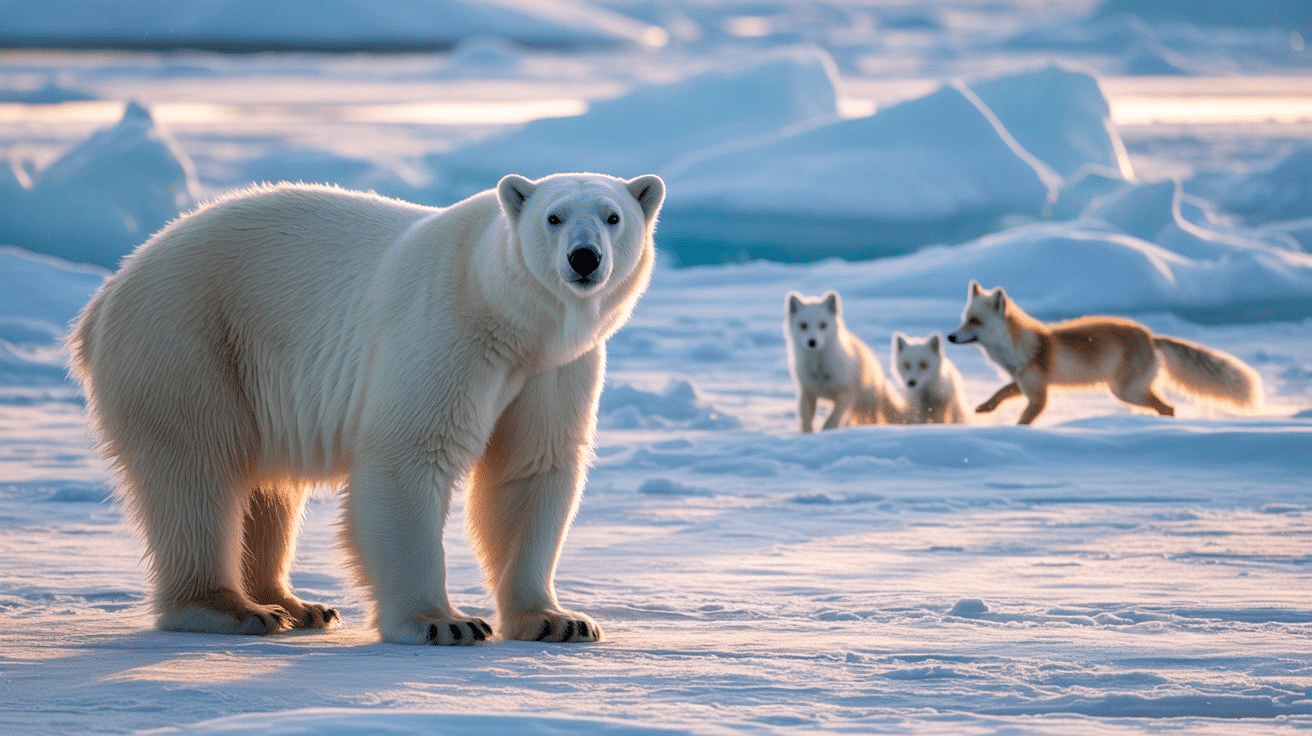The arctic region is home to some of the most amazing animals on our planet. These tough creatures survive in a frozen world where temperatures can drop to -50°f!
From the mighty polar bear to the small arctic fox, these animals have incredible ways to stay warm and find food in the icy landscape.
They have special features like extra-thick fur, layers of fat called blubber, and smart hunting skills that help them thrive in the freezing cold. Want to know what makes these snow-loving arctic animals for kids so interesting?
Get ready to learn some awesome facts about the real-life heroes of the north pole that will amaze your friends and family!
What Are Arctic Animals?
Arctic animals are incredible creatures that survive in one of earth’s harshest environments.
The Arctic region surrounds the North Pole and spans parts of Canada, Russia, Alaska, Greenland, and Nordic countries.
These animals have evolved key adaptations to survive extreme cold. Thick fur or feathers insulate body heat, while blubber adds warmth and stores energy.
Compact bodies and small extremities reduce heat loss and frostbite risk. Some also change fur color seasonally for better camouflage.
The arctic is home to iconic wildlife like polar bears, arctic foxes, musk oxen, walruses, seals, arctic hares, and snowy owls. Marine species include narwhals and beluga whales.
Their survival strategies include:
- Specialized feet that work like snowshoes on snow
- Advanced hunting techniques to find scarce food
These extraordinary adaptations allow arctic animals to thrive where temperatures can plummet to -50°f, demonstrating nature’s incredible ability to adapt to even the most challenging conditions.
Chilling Facts About Arctic Animals for Kids

Ever wonder how animals survive in the freezing arctic? Get ready for some super cool animal secrets that will blow your mind!
1. Polar bears have black skin
Underneath their thick white fur, polar bears have black skin that absorbs heat from the sun. This hidden feature helps keep them warm, even while walking across frozen seas.
2. Arctic foxes change color
Arctic foxes turn white in the winter to blend in with snow, and brown or gray in the summer to match the rocks and plants. This seasonal color change helps them hide from predators and sneak up on prey.
3. Narwhals are real!
Narwhals are known as the “unicorns of the sea” because of their long, spiral tusk—which is actually a tooth! It can grow over 10 feet long and may help the narwhal sense changes in its surroundings.
4. Snowy owls have feathered feet
Unlike most birds, snowy owls have thick feathers covering their feet and legs. These feathery “boots” help them stay warm while hunting in freezing temperatures.
5. Walruses use their tusks to climb
Walruses use their long tusks to haul their huge bodies out of the icy water and onto the ice. They also use them to defend themselves and to show dominance in the group.
6. Caribou have snowshoe hooves
Caribou, also known as reindeer, have large, wide hooves that spread out to keep them from sinking into the snow. Their hooves also help them dig through snow to find food like moss and lichen.
7. Arctic hares can run up to 40 mph
These fast-moving hares can run as fast as a car in a school zone! Their powerful legs help them outrun predators like foxes and wolves.
8. Musk oxen wear double coats
Musk oxen are built for winter. They have a soft inner layer of wool called qiviut (one of the warmest natural fibers) and a long, shaggy outer coat that blocks wind and snow.
9. Beluga whales can talk
Beluga whales are sometimes called the “canaries of the sea” because they make many different sounds, including whistles, clicks, and chirps. These sounds help them communicate and find their way under the ice.
10. Lemmings tunnel under snow
Even in the coldest months, lemmings stay active by digging tunnels under the snow. This insulated world protects them from freezing temperatures and hungry predators.
11. Ermines turn white in winter
Also known as stoats, ermines have brown fur in the summer and turn bright white in the winter. Their color change helps them stay hidden while hunting small prey in the snow.
12. Seals stay warm with blubber
Seals have a thick layer of fat called blubber that keeps their bodies warm in icy waters. It also helps them float and store energy during long dives.
13. Arctic fish have antifreeze blood
Some fish that live in Arctic waters produce special proteins in their blood that stop ice crystals from forming. This “antifreeze” keeps them alive in water that would freeze other fish solid! This fact about arctic wildlife shows how even the smallest creatures adapt to survive.
Arctic Animal Food Chains: Who Eats Who?
The arctic food chain connects all life in this extreme environment through vital feeding relationships. Every organism plays a crucial role in sustaining this flimsy arctic ecosystem.
Marine food chains begin with microscopic phytoplankton that convert sunlight into energy. These tiny producers feed zooplankton and krill, which become food for arctic cod and other small fish.
Seals hunt these fish beneath the ice, while polar bears—the arctic’s apex predators—depend on seals for survival.
On land, hardy plants like lichens and mosses support herbivores such as caribou, musk oxen, and arctic hares. These plant-eaters then become prey for predators including arctic foxes and arctic wolves.
Some predators, like the opportunistic arctic fox, bridge both ecosystems by scavenging polar bear leftovers.
The interconnected nature of arctic food chains makes them particularly vulnerable to disruption. When climate change reduces sea ice, polar bears lose hunting grounds, affecting their ability to catch seals.
This ripple effect demonstrates how each link depends on the others for the entire system to function properly.
Understanding these relationships helps highlight the importance of protecting this unique and fragile northern ecosystem.
Amazing Arctic Species: The Polar Bear and Arctic Fox
The polar bear stands as one of the most remarkable arctic species, perfectly adapted to life on the ice. These powerful hunters can swim for days across open water and have an incredible sense of smell that helps them detect seals from miles away. The arctic fox, another fascinating arctic animal, follows polar bears to scavenge leftover meals, showcasing the clever survival strategies found throughout arctic wildlife.
Children often find these animal facts particularly exciting when learning about how different species work together in the harsh arctic environment. The arctic tern, which makes the longest migration of any bird, also calls this region home during summer months, adding to the diversity of arctic wildlife.
Conclusion
Arctic animals are incredible survivors in Earth’s coldest places. These amazing creatures show us how nature adapts to extreme conditions through clever tricks and special features.
Learning about arctic animals for kids understand why protecting these habitats matters. Climate change threatens their homes, making conservation efforts important.
Share these cool facts about arctic animals with friends and family to spread awareness about these amazing creatures. Check out more posts about the arctic hare and other fascinating arctic wildlife to continue your learning journey!




